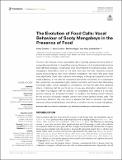Files in this item
The evolution of food calls : vocal behaviour of sooty mangabeys in the presence of food
Item metadata
| dc.contributor.author | Quintero, Fredy | |
| dc.contributor.author | Touitou, Sonia | |
| dc.contributor.author | Magris, Martina | |
| dc.contributor.author | Zuberbühler, Klaus | |
| dc.date.accessioned | 2022-07-27T16:30:06Z | |
| dc.date.available | 2022-07-27T16:30:06Z | |
| dc.date.issued | 2022-06-30 | |
| dc.identifier | 280632410 | |
| dc.identifier | d4b99994-a690-4d46-9968-9c4186c00e21 | |
| dc.identifier | 85134227050 | |
| dc.identifier | 000827325800001 | |
| dc.identifier.citation | Quintero , F , Touitou , S , Magris , M & Zuberbühler , K 2022 , ' The evolution of food calls : vocal behaviour of sooty mangabeys in the presence of food ' , Frontiers in Psychology , vol. 13 , 897318 . https://doi.org/10.3389/fpsyg.2022.897318 | en |
| dc.identifier.issn | 1664-1078 | |
| dc.identifier.other | RIS: urn:08883077229452AF68959B4C8EEA0924 | |
| dc.identifier.other | ORCID: /0000-0001-8378-088X/work/116597612 | |
| dc.identifier.uri | https://hdl.handle.net/10023/25731 | |
| dc.description | Funding: This research was funded by the Swiss National Science Foundation (310030_143359; NCCR Evolving Language, Swiss National Science Foundation Agreement #51NF40_180888) and the European Research Council (PRILANG GA283871). | en |
| dc.description.abstract | The two main theories of food-associated calls in animals propose functions either in cooperative recruitment or competitive spacing. However, not all social animals produce food calls and it is largely unclear under what circumstances this call type evolves. Sooty mangabeys (Cercocebus atys) do not have food calls, but they frequently produce grunts during foraging, their most common vocalisation. We found that grunt rates were significantly higher when subjects were foraging in the group’s periphery and with small audiences, in line with the cooperative recruitment hypothesis. In a subsequent field experiment we presented highly desired food items and found that discovering individuals called, unless harassed by competitors, but that the calls never attracted others, confirming that the grunts do not convey any information referential to food. Our data thus suggest that the evolution of cooperative food calling is a two-step process, starting with increased motivation to vocalise in the feeding context, followed by the evolution of acoustic variants derived from context-general contact calls. This evolutionary transition may only occur in species that feed on clumped, high-quality resources where social feeding is competitive, a condition not met in sooty mangabeys. | |
| dc.format.extent | 9 | |
| dc.format.extent | 1279065 | |
| dc.language.iso | eng | |
| dc.relation.ispartof | Frontiers in Psychology | en |
| dc.subject | Cercocebus atys | en |
| dc.subject | Close-range vocalisations | en |
| dc.subject | Food-associated calls | en |
| dc.subject | Grunt | en |
| dc.subject | Vocal communication | en |
| dc.subject | QL Zoology | en |
| dc.subject | BF Psychology | en |
| dc.subject | NDAS | en |
| dc.subject | MCC | en |
| dc.subject.lcc | QL | en |
| dc.subject.lcc | BF | en |
| dc.title | The evolution of food calls : vocal behaviour of sooty mangabeys in the presence of food | en |
| dc.type | Journal article | en |
| dc.contributor.institution | University of St Andrews. Institute of Behavioural and Neural Sciences | en |
| dc.contributor.institution | University of St Andrews. Centre for Social Learning & Cognitive Evolution | en |
| dc.contributor.institution | University of St Andrews. School of Psychology and Neuroscience | en |
| dc.identifier.doi | https://doi.org/10.3389/fpsyg.2022.897318 | |
| dc.description.status | Peer reviewed | en |
This item appears in the following Collection(s)
Items in the St Andrews Research Repository are protected by copyright, with all rights reserved, unless otherwise indicated.

